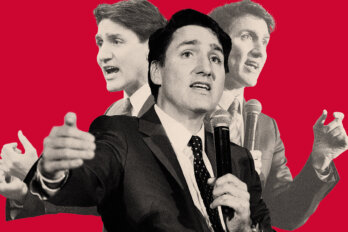In early November, Doug Ford’s Conservatives faced a long-simmering crisis. At the height of the pandemic, Ontario’s schools had been closed for months longer than those in any other Canadian jurisdiction. Now, the Canadian Union of Public Employees (CUPE), representing 55,000 education support workers, was threatening a strike that would shutter many schools once again.
Ford’s Conservatives responded with the Keeping Students in Class Act, which imposed a new collective agreement backed by section 33 of the Canadian Charter of Rights and Freedoms—the so-called notwithstanding clause that allows legislatures to temporarily override certain Charter rights, including the right to strike.
The government claimed the clause was necessary to avoid legal challenges that would “create destabilizing uncertainty for students and families.” Meanwhile, the Ontario Federation of Labour decried Ford’s “full-frontal attack on basic labour freedoms in Ontario,” and Justin Trudeau criticized what he saw as Ford’s cavalier invocation of section 33. “The suspension of people’s rights is something that you should only do in the most exceptional circumstances,” Trudeau told reporters, “and I really hope that all politicians call out the overuse of the notwithstanding clause.”
There are already plenty of examples of how destructive the clause can be in undermining Charter rights. In June 2019, Quebec’s Coalition Avenir government invoked the clause to pass Bill 21, “the Act respecting the laicity of the State,” which barred public servants (including teachers, judges, police officers, and lawyers) from wearing religious symbols while performing professional duties. Unsurprisingly, lawsuits ensued. According to her affidavit, Nafeesa Salar, a Muslim woman who earned her bachelor of education from McGill University in 2015 and dreamed of becoming a school principal, now feels “like a second-class citizen in my own province” because she wears a hijab. “The Act sends the message that people of faith like myself are unwelcome in the public sector in Québec,” said Amrit Kaur, a practising Amritdhari Sikh, in her own affidavit. Kaur, too, had trained as a teacher. Now, “I feel like people who don’t know me . . . are asking me to leave [the] province because of my religious beliefs.” Ultimately, Kaur left Quebec for a teaching post in British Columbia.
They are far from alone. In an interview with the CBC, a leading researcher for the Association for Canadian Studies found “disturbing” levels of “disdain, hate, mistrust, and aggression” directed toward religious minorities in Quebec. Seventy-eight percent of Muslim women said that their feeling of being accepted in Quebec society has worsened since the passage of Bill 21.
Outside of Quebec, where it has been invoked by Parti Québécois and Coalition Avenir governments, Conservatives have proven especially keen on the notwithstanding clause. Long before Doug Ford became a section 33 adherent in Ontario, Ralph Klein’s Conservative government proposed to invoke the clause to impose a cap of $150,000 (and avoid ensuing constitutional challenges) to compensate victims of the forced sterilizations that took place between 1928 and 1972. Many victims had been diagnosed as “morons” by Alberta’s Eugenics Board and sterilized as children. Widespread outrage forced Klein to back off, but he again attempted to invoke the clause by amending the Marriage Act to block same-sex marriage in Alberta. This attempt, too, ended in failure when the Supreme Court found that the definition of marriage fell under federal jurisdiction. Essentially, Klein had invoked the clause to protect a change that was not in his power to make.
Canadians believe that we have certain inalienable rights and freedoms—right to life, liberty, and security of the person; freedom of expression; freedom of religion—and that these cannot be snuffed out. After all, they are inscribed in the Charter. But the Charter also includes section 33, which means that these very rights and freedoms can be suspended by any provincial or federal legislature that invokes the notwithstanding clause. And this raises a troubling question: Why go to the trouble of codifying a Charter of Rights if that very Charter contains a kill switch for the rights themselves?
It seems clear that the recent use of the notwithstanding clause has fallen short of the “exceptional circumstances” requirement that conceivably necessitates its use. Unfortunately, we need more than the wish that politicians “call out” the overuse of the notwithstanding clause. Instead, the Liberals should champion a constitutional amendment that would repeal the notwithstanding clause—thereby building upon and strengthening the great national project initiated by Justin Trudeau’s father.
The origins of the notwithstanding clause go back to deliberations between the federal government and the provinces in the lead-up to Canada’s emergence as a sovereign nation. Before the early 1980s, Canada was still a legal colony of Great Britain. Prime Minister Pierre Trudeau hoped to change that by “patriating” and Canadianizing the British North America Act of 1867. The resulting Constitution Act of 1982 would allow Canada to change its Constitution without Britain’s approval and entrench the Charter of Rights and Freedoms as the foundation of the laws of the land. But, to get there, Trudeau needed the premiers to agree on how the Constitution should be amended. Only the premiers of Ontario and New Brunswick supported Trudeau. The rest, hoping to tilt power in the direction of provinces, formed the “Gang of Eight” to put up a unified front.
Trudeau turned to the public for support. His Liberals created the Special Joint Committee on the Constitution, consisting of ten senators and fifteen MPs, to facilitate public consultation on a draft of the Constitution. The proceedings, which were broadcast on national television, offered an extraordinary window into the real-time creation of our nation’s bedrock document. In 267 hours of committee hearings over three months, including ninety-seven hours of clause-by-clause analysis, the Constitution took shape. Hundreds of civil liberties and social justice groups submitted briefs and made oral arguments, playing a crucial role in strengthening the Charter of Rights.
Just as crucially for Trudeau, the public hearings captured the imagination of ordinary Canadians, who now overwhelmingly supported what came to be known as “the people’s package.” Justice minister Jean Chrétien goaded his Gang of Eight rivals, saying that if they came out against the rights of women and Indigenous people, “I am going to cut you to pieces.”
Still, one final concession was necessary to appease the premiers. That concession took the form of an override clause. Section 33 “provided the decisive compromise necessary to secure agreement to the adoption of the Canadian Charter,” constitutional law expert Lorraine Weinrib wrote in a scholarly survey of the process. Yet section 33 wasn’t part of the draft Charter examined by the Special Joint Committee. That meant the Canadian public and civil rights organizations never had an opportunity to weigh in on its inclusion during consultations.
Why did Pierre Trudeau’s government accept section 33? Partly, they believed that any problematic use of the clause would amount to major political damage for those who threw the switch. Trudeau insisted that the clause expire five years after it was invoked, which would assure voters of an opportunity to intervene at the ballot box before it could be renewed. Chrétien saw potential use in the clause as “a safety valve to correct absurd situations without going through the difficulty of obtaining constitutional amendments.” And any government that trampled the rights and freedoms of its own people would face the wrath of the electorate.
Recent events have exposed the naïveté of both of the framers’ assumptions. After invoking the clause to pass Bill 21, Quebec voters rewarded François Legault with a splendid majority in October’s provincial election. In 2018, Doug Ford used the clause to cut the size of Toronto’s city council nearly by half during a municipal election; in 2021, Ford used it again to curtail election advertising, with unions charging that it limited their free speech and undermined dissent. Did it hurt him? Hardly. Ontario voters handed Ford another majority in June. And then he invoked the clause a third time, again to bludgeon his political adversaries in the unions.
It’s hard to believe this is what the architects of the Charter had in mind. What happened? Did the Canadian electorate fail to punish governments that desecrate the Charter for political gain? A more likely explanation is that the framers committed a colossal blunder. They included a big, shiny “rights nullification” button in our Charter and assumed no one would press it because Canadians are nice. In reality, it has left our fundamental rights subject to sudden amputation according to provincial whim.
Given this noxious history of using or trying to use the notwithstanding clause to shortchange the victims of sterilization, prevent same-sex marriage, curtail religious freedoms, gerrymander elections, attack unions, and crush political enemies, you would think there must be some compelling reason to keep the clause. Those in favour of it present two main lines of argument.
Some see section 33 as a bulwark against hyperactive courts that would rule our lives by judicial fiat. The override may have been conceived as an exceptional power deployed in rare cases of judicial overreach, this line of reasoning goes, but those cases are no longer rare. As Howard Anglin, Stephen Harper’s former deputy chief of staff, argued in The Hub: “Once the courts made exceptional cases the norm, governments were not only justified but practically compelled to establish a counter-norm of using the notwithstanding clause to restore balance.” According to Anglin’s logic, the Supreme Court’s 2015 decision affirming the fundamental right to strike “practically compelled” Ford to use the override in 2022—just as courts ruling in favour of same-sex marriage and compensation for forced sterilization “practically compelled” Klein to attempt the override in Alberta. In other words, this argument goes, the premiers were acting for the public good.
But is that true? Look at the historical record: section 33 has been invoked not when courts overreach into the operations of government but when governments overreach into the lives of citizens. And this government overreach is far more insidious than the judicial interference that worries Anglin. That’s because government overreach in the form of section 33 involves taking away a right Canadians have. Does that sound like a balance being restored? Pierre Poilievre and the Conservatives spent months attacking the federal government’s invocation of the Emergencies Act, for infringing upon the Charter rights of Tamara Lich and the rest of the Ottawa convoy. Yet, confronted with a concrete instance of the suspension of rights in Ford’s use of section 33, Poilievre was mum. When Trudeau asked him about the notwithstanding clause in the House of Commons, Poilievre changed the subject to ArriveCan, the problem-ridden COVID-screening app for border crossings.
Anglin and other fans of section 33 argue that the notwithstanding clause is “more democratic” than rule by the bench, because voters can replace legislators but not judges. But this works against why we have the Charter in the first place, which is to elevate certain rights beyond the democratic fray. Your right to life, freedom of expression, and freedom of religion should not be contingent upon my vote. Indeed, the purpose of enshrining such human rights is to ensure that they are not subject to mob rule. These rights were expressly designed to protect religious, sexual, or ethnic minorities from the tyranny of the majority. To appeal to “democracy” in the context of section 33 is to completely misunderstand the rationale behind the rights themselves. “Democracy” is one of the things human rights are supposed to defend against.
Lorraine Weinrib, the constitutional lawyer, presents a more compelling case for the notwithstanding clause. Weinrib is sharply critical of recent invocations of the clause but believes that we “don’t want to put all of our eggs in one institutional basket.” If you’re a progressive, you might imagine a scenario in which the Supreme Court has been populated with improperly trained judges appointed by successive Conservative governments. Under such circumstances, you would be grateful for the legislative override. In the meantime, Weinrib believes that recent excessive uses of section 33 are best fought out in court.
The problem is that constitutional law moves at a glacial pace and legislatures are comparatively nimble. Ford, in particular, has demonstrated a willingness to hastily convene the legislature and ram his bills through in closed sessions with no debate. Meanwhile, in Quebec, legal challenges to Bill 21 place the onus squarely on the victims to demonstrate that they have been adversely affected—rather than on the government to show why it was necessary in the first place. Quebec’s Bill 21 may yet be struck down if it is found to create gender inequality (since the Charter’s gender provisions are exempt from section 33). Such rulings, if they do arrive, will come as small consolation for the women whose professional aspirations have already been shattered and do nothing to prevent future abuse of the clause. The only way to ensure the integrity of Canadians’ Charter rights is to repeal the clause itself.
Would such a move be possible? Certainly, prime minister Paul Martin believed so when he pledged that “the first thing” he would do upon reelection would be to remove Parliament’s ability to use the clause. (Martin lost to Stephen Harper’s Conservatives in 2006.) If Justin Trudeau’s Liberals are serious about repealing the clause, they should take their cues from the Canadian people, not the courts. Building consensus through a national referendum would put the Conservatives in the rhetorically awkward position of arguing “against” democracy. More importantly, such a referendum would likely reveal, according to a post by constitutional lawyer Deborah Coyne on her website, “strong popular support for repealing” the clause, thus rendering the premiers and prime minister “morally compelled to pass the necessary resolutions to amend the constitution.” Inevitably, some will argue that repealing section 33 will be difficult. If politicians only ever took the easy road, Canadians would have no Charter in the first place.
The Charter has enjoyed enormous popularity: one national survey found it to be our most important national symbol, more beloved than hockey. Yet the Charter contains the seeds of its own destruction. Framers believed that use of the override would be rare and that any controversial invocation would be punished by an astute electorate. The very opposite is proving true. Its use is being normalized by majority governments trying to cudgel political opponents, who are then rewarded with even greater political power. Far from operating as a “safety valve to correct absurd situations,” as Chrétien predicted, the override has created absurd situations. It has allowed governments to infringe upon Canadian liberties and further oppress minorities.
In 1989, Brian Mulroney argued that any Constitution “that does not protect the inalienable and imprescriptible individual rights of individual Canadians is not worth the paper it is written on.” We can either repeal the notwithstanding clause of the Charter or watch as our Charter rights themselves are repealed by future invocations of section 33. Abolishing the clause would make for a stronger Charter and a freer nation.





